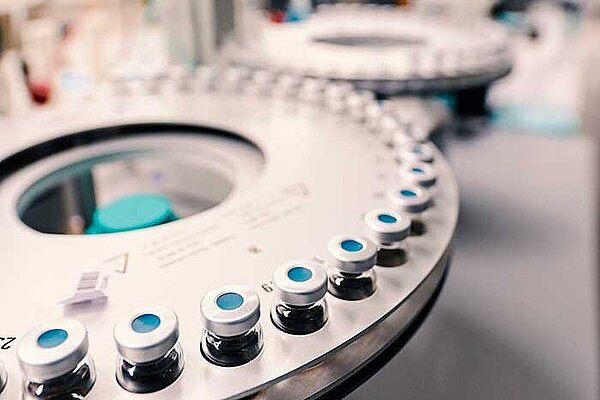A lab report with no indication of water content
Year of publication: 2023
In our laboratory reports, you have always until now reported a value for the water content in %, which was determined using FT-IR. For the first time, we have now had a polyglycol-based oil analysed with one of your all-inclusive standard sets and this value is missing from the laboratory report. Is there a reason for this?
Don't worry, we haven't forgotten the value for water using FT-IR (%)! With your polyglycol oil, it is just not expedient to determine the water content using this method. And there are reasons for this, as well as an alternative option!

Polyglycols are different
Polyalkylene glycols (PAG), referred to as polyglycols for short, are not oils in the conventional sense, but polyethers. These are produced from polyvalent alcohols by polymerisation. As polyglycol oils have a high natural capacity to absorb pressure, they are primarily used for lubricating roller and slide bearings and worm gears. As high-temperature oils, they are used, among other things, in compressor and hardening oils as well as in metalworking and heat transfer fluids. Polyglycol oils have better physiological compatibility than mineral oils and are therefore often used as lubricants in the food industry in accordance with NSF-H1. They also serve as the basis for flame-retardant hydraulic fluids as well as biodegradable HEPG (hydraulicoil environmental polyglycol) hydraulic fluids.
Water in polyglycols
Polyglycol oils generally have an increased dissolving power of water. Some of them are even hygroscopic. If they have absorbed water, it does not settle and therefore cannot be removed.
Depending on the raw materials used and the polymerisation, polyglycol oils can absorb water in a very wide concentration range from a few hundred ppm to a double-digit percentage range. Here, however, water determination with the IR method reaches its limits here just as much as with ester-based synthetic oils or lubricating greases. There is one complicating factor when examining glycols: so-called “hydroxy groups” are found in their structure. These are detected in the IR spectrum in the same range as water.
This can lead to significant blurring in the determination of water. A titrator is used to determine the water content of polyglycols as a reliable alternative. The Karl Fischer method is used for this purpose. Titration is a procedure used in quantitative analysis in chemistry. A known substance such as water, the concentration of which in oil is unknown, is reacted in a chemical reaction using a standard solution, the concentration of which is precisely specified. Karl Fischer’s so-called coulometric method can detect extremely low water concentrations in trace levels ranging from 10 ppm (mg/ kg) to values of around 10,000 ppm (mg/kg), i.e. 1%, in the oil.
This process is therefore the method of choice for polyglycols and ester-based products, but also for mineral-oil-based insulating oils, many hydraulic and gear oils, as well as refrigerant compressor oils, which can only absorb small quantities of water during operation. For polyglycol-based products that are inherently high in water content, such as flame-retardant hydraulic fluids, we determine the water content using the volumetric variant of Karl Fischer titration.
You can also read the article “This is how precisely OELCHECK detects water”. Published in OELCHECKER Summer 2021.
Water determination according to Karl Fischer
Customised OELCHECK all-inclusive analysis sets with a combination of the appropriate test methods are available for every type of lubricant or every operating material, every industry and every issue. Our analysis set 1 (white set) already contains water determination using FT-IR for most applications.
However, as explained above, in many cases it is the better choice to perform water determination using the Karl Fischer method. We will be happy to help you select the appropriate set.
OELCHECK Spring 2023, page 10



